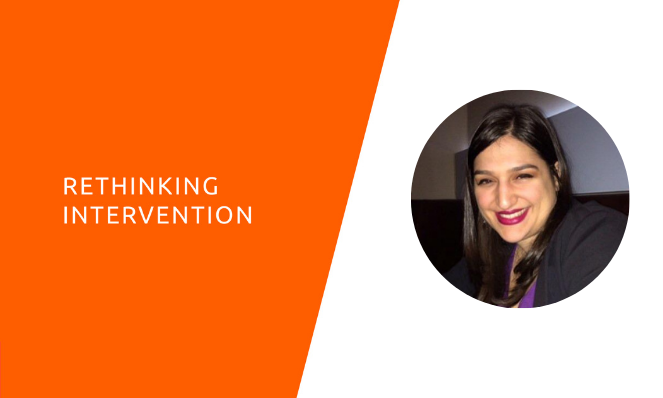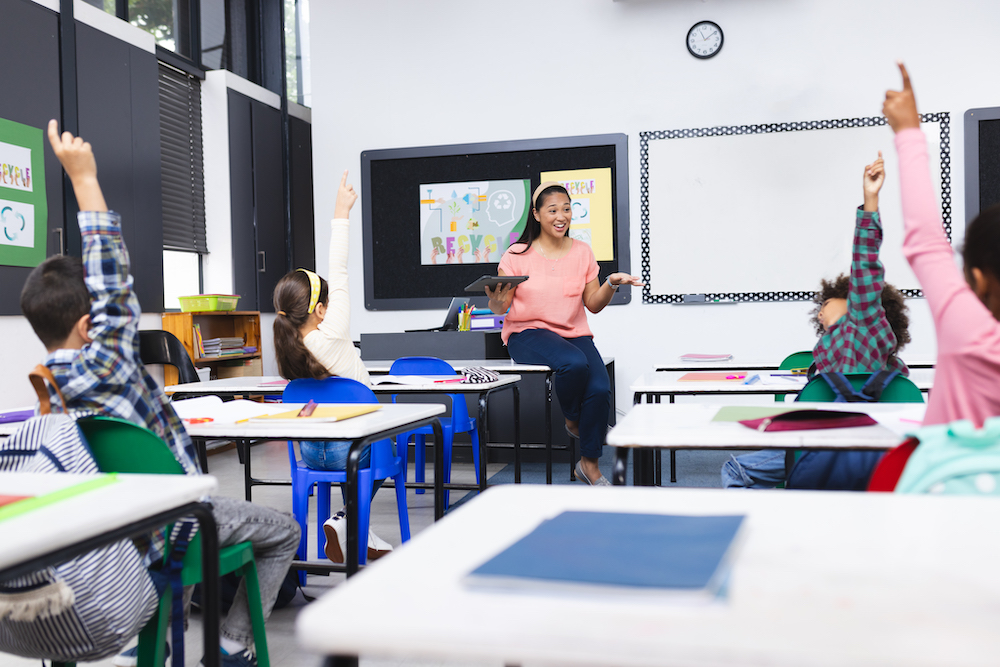
Dora Kastel, New Visions for Public Schools
Dora Kastel supports science teaching and learning in the New Visions for Public Schools network through the development of standards-aligned instructional materials along with facilitation of teacher professional learning.
Dora spoke to Jessica Henderson, Director of Science at Instruction Partners, about the power of connecting science instruction to students’ real-life experiences.
Watch or read the full conversation below.

JH: How did your personal experience in school inform your perspective and the work that you do?
DK: Working in education and teacher education often has me reflecting on my own learning experiences, particularly in STEM. When I grew up, the way math was taught assumed a one-size-fits-all model. That model happened to work for me as a learner for a long time. Once I got to middle school, it stopped working because I was really bored. I was not challenged. Even in the accelerated class, I remember being bored out of my mind. In high school, similarly, I got good grades, and I was bored. I thought that I was going to be a math major one day.
Then, I got to college and I hit a ceiling. I nearly failed calculus. I did not become a math major. I realized that the fact that I wasn’t taught in a way that supported conceptual development meant I had all these gaps. I could get away with being successful for a long time because I knew how to “do school.” That privilege of being able to do school worked for me for a really long time, until it didn’t. It was painful to learn that. The one-size-fits-all approach might work for some kids and not other kids. It might work for some kids temporarily, but then stop working for those kids at some point. My experience gave me a significant amount of buy-in to foundational understanding and conceptual understanding in any discipline being more important than memorization or success on standardized testing, because those measures didn’t show evidence that I actually understood what was happening.
I did end up getting an advanced degree in math education—one of my master’s degrees is in science and the other is in math education, and I did end up becoming a math and science teacher. However, I struggled much more as a math teacher than I did as a science teacher because of the lack of foundational, conceptual understanding.
JH: It is so interesting to think about what it means to have success as a learner. How do you think that experience has really impacted how you approach education?
DK: With regards to the new NGSS work that we’ve been doing in the last few years, I’m really thinking about the idea of evidence of learning. When we’re looking at standards and thinking about how we are going to make claims about what students know and can do, grades are not sufficient enough. Simplistic, multiple-choice answers to things aren’t enough evidence to really make a true claim about what students know and can do. My grades were really good, but when I actually scratched the surface, there’s not a lot of depth, procedural understanding wasn’t enough.
JH: What strategies or approaches have you seen work that you would champion for advancing student learning in science?
DK: One of the most important things I learned when I was a classroom teacher was the importance of having science teachers in professional learning immersed in the kinds of learning being taught to them so that they can teach their students effectively.
In order to get the teaching force on board with making positive shifts in science education, it’s not enough for the researchers and leaders to judge them and say “you’re not doing something right” or just tell them how to do it better. The way to shift thinking, which is both true for students and teachers, is to actually have them live it and do it. One of the biggest challenges with the most recent reform work around three-dimensional phenomena-based instruction has been for teachers who’ve never learned in that way to experience it for themselves. Every time we do a workshop, as soon as a person who’s new to this way of learning starts to experience it for themselves, they immediately give feedback like, “Oh, this is what you’re trying to do. This is going to be so great for the kids. This is incredible. I don’t know if I can do it. I don’t know if my kids can do it. But I see the value in it, I see how important it is, help me get there.” They need that immersive experience in order to have those “aha” moments. We build that into the professional learning model. It works even if it’s just a tiny experience, it doesn’t have to be a two-week long institute. To give just enough of a taste of what it feels like for a student learning in this way can be transformative for a teacher. We also have been working with administrators, similarly, to help them experience the learning. Or even to get a principal to do a science activity from the perspective of a science learner and say, “Oh, this is what you’re trying to do. Now I see it. Now I can give my support for it.” That is one of the most important things that works in teacher education that we need to continue doing no matter what.
JH: Have you seen widespread buy-in to that approach in teacher ed or in the professional learning that’s being developed for teachers?
DK: I think it’s becoming more widespread, certainly more than it was when I was becoming a teacher. I was privileged enough that when I became a teacher, I immediately was able to be part of curriculum-based professional learning that included immersion in the science curriculum materials. It was grounded in high-quality instructional materials that were consistent with reform efforts at the time. So, I don’t know what it’s like to be a teacher who doesn’t have access to high-quality materials or access to professional learning that includes immersion. I do recognize that a lot of teachers don’t have access to either of those things. Those are two critical ingredients to success with this work. While we’re seeing shifts and we’re seeing increasing buy-in that immersion is necessary, the constraints around time and money are always a barrier and always a factor. This is something we need to continue to advocate for. But I’ve also seen a lot of progress. I think that when we get teachers and administrators in our workshops, there’s more familiarity with this professional learning model of having you do the science before learning about the science teaching. I’m seeing more and more of it, but we’re not totally there yet.
JH: Considering where science education was pre-pandemic, can you think of any things that educators could do to support students who have experienced disrupted schooling and are coming back into classrooms over the next year? What approaches do you think that we should really hold onto to support student learning in this unprecedented situation?
DK: A lot of the work that we were already doing around NGSS shifts can help teachers address that right now. It pains me when I look at social media and see teachers saying that they’re going to “take a break” from NGSS in order to go back to what they were doing before because it’s “easier” and, “the kids don’t need that right now.” They go back to these traditional approaches rather than recognizing that focusing on phenomena-based instruction that’s relevant to kids right now actually can help.Kids, whether they’re in school or not, are in the world, and they have knowledge, and they have experiences, and we have an opportunity both now and after the pandemic to connect to their real-life experiences. We have a routine around phenomena where after we’ve introduced the phenomena in a unit or lesson, where students can actually share, “What does this remind you of? Is this like something else that you’re familiar with?” Those kinds of routines are so critical. It’s not necessarily about catching them up, it’s that the science they’re learning has to be relevant and has to help them make meaning of their natural world. That’s the NGSS piece that I hope teachers hold on to now during the pandemic, to help them after.
JH: I love the idea that it’s not about catching them up.
DK: It’s a whole generation. All the kids are going through this collectively. There are, of course, going to be further inequities. But this is a worldwide phenomenon right now. My hope is that the system recognizes that this whole generation of kids are going through this and that the system then supports them, as opposed to it being the responsibility of the individual school or teacher to fix this.
JH: It brings up the power of how you’re thinking about quality experiences for learning. If the trade off to catch a student up is to decrease the quality of the instruction, or to change the ability of students to engage with instruction in an authentic way, then what are we really catching them up to?
DK: We will further the inequities if we revert back and focus on catching up and start rewarding what would now be considered racist practices in the classroom—only pushing memorization, pushing for coverage. By trying to revert back to those traditional approaches, it’s going to further those inequities.
JH: Speaking of things that could cause harm, from your experience, what are some things that we should really keep away from that can cause harm for students?
DK: Pushing for coverage does harm. Memorization as evidence of success is problematic, and we know it doesn’t work. Pushing for just vocabulary prior to experience doesn’t work—that’s a big one in science. I’m still fighting the battle to help non-science ed people understand that front-loading vocabulary is very problematic in science, particularly for English language learners who have no concept of the thing that they’re attaching the word to. Until you have that experience, the word is meaningless.
Another thing we know doesn’t work is a top-down approach, whether it’s a district pushing teachers to do something , or teachers trying to get the kids to do something rather than trying to put the agency on the learners to figure things out.
We know that not acknowledging trauma doesn’t work. It’s there whether we acknowledge it or not. We can pretend that the kids are fine, or that the teachers are fine, or even that the administrators are fine, but nobody’s fine. Until we acknowledge that, I don’t know how anyone can learn. I think it’s essential that we’re really making sure that we’re building in routines for the SEL work right now.
To get specific about science, I still see teachers struggling to understand that if they’re the ones explaining something to a student, then they’re the ones who are going to understand it, not the student. As we express things and talk about things and process our ideas, the one who is talking is the one who is learning. We know that there needs to be some other type of sense-making activity around what you’re listening to or watching or reading. Teachers can’t just explain science or have students watch videos of them explaining something and expect that students are just going to absorb it like a sponge. That’s just not how learning works. Teachers still say, “I just don’t understand why they got it wrong on the state exam. I know I taught that.”It’s not about how well you explain it to the kids. It’s about the students explaining it. It’s about the discourse between students. It’s probably true in all disciplines, but I think it’s particularly necessary in science right now for us not to lose the idea that the person doing the talking and the sense-making is the person doing the learning.
JH: That is so key in a time when we’re trying to figure out how to engage with students and how to make sure they can engage back with us, and how to make sure we’re available to them and knowledge is available to them.
DK: It is about the kids. It’s why we write “student-centered” in our curriculum approaches and our professional learning approaches. In everything we’re doing, we’re trying to put students at the center.


